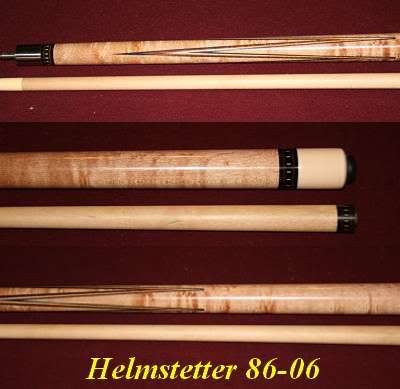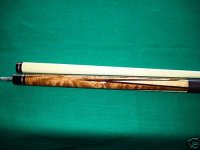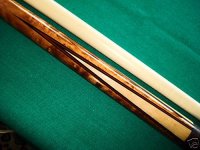Excuse my ignorance but what is a full splice cue and what are the advantages of using one? Can someone please include a drawing.
You are using an out of date browser. It may not display this or other websites correctly.
You should upgrade or use an alternative browser.
You should upgrade or use an alternative browser.
What is a Full Splice Cue?
- Thread starter ArizonaPete
- Start date
ArizonaPete said:Excuse my ignorance but what is a full splice cue and what are the advantages of using one? Can someone please include a drawing.
If you think of your basic old fashioned four pointed bar stick, then you have the general idea of what a full splice cue is. Basically, it is a nose and butt section spliced together, with no handle added in between. Simply two pieces of wood joined/spliced into one another.
While mine is a fancier version, it is still a full splice cue:

Additionally, there are full splices done with veneers added:

Many of these types of cues are left wrapless, however there are some players who will have a wrap added, as they have issues with sweating hands and wrapless cues.
There are some who think that the full splice cue just 'feels' better with regards to play...'solid' is often used to describe. However, since 'hit' and/or 'feel' is really quite subjective, it is a decision one would have to make for themselves. There are many fine cue makers who craft an equally solid playing short splice cue.
Lisa
Last edited:
Full Splice
Check out Arnot's website with pictures:
http://www.arnotq.com/pages/21/21.html
Hope these help.
Check out Arnot's website with pictures:
http://www.arnotq.com/pages/21/21.html
Hope these help.
Thanks to Lisa and Robert. Your input has been very helpful.
ArizonaPete said:Thanks to Lisa and Robert. Your input has been very helpful.
I agree...thanks Robert for the nice link...pretty much explains it in a nutshell.
While the pics may may it look like it is an easy construction technique...making a well crafted full splice blank with centered, even points is not so much. But when it is done well, it can make for a really fun playing cue. :thumbup:
Lisa
cyrex said:Another full splice for you..
Bocote into maple with Titlist color veneers

That bocote is just crazy!! :thumbup2:
Lisa
trustyrusty said:View attachment 77263
View attachment 77264
View attachment 77265I've wondered about the different kind of splices too. Is my McDermott a full splice, short splice, etc...?
It doesnt look like it. I am used to seeing the points come together more, those points look like inlays and not the marriage of two woods. JMHO..
Maybe my follow up question should be in a new thread, but it does concern full splice cues.
In our rec room at work, we have a couple of pool tables (AMC) and several house cues. I would imagine these full splice house cues probably cost about $30 a piece (if even that). I noticed the points on these cheap cues are razor sharp (not rounded ).
I guess I don't understand why certain cues like Schon's, Predators, and many others have rounded points instead of razor sharp points? I have always thought that production cues that were CNC'd had rounded points and this was done because its 'easier' for the cue maker and requires less time. If this is the case, how is it that many crappy house cues I see have razor sharp points? I can't imagine the maker spending extra quality time sharpening up the points only to sell the cue for 20 or 30 bucks.
Thanks in advance for you response(s).
In our rec room at work, we have a couple of pool tables (AMC) and several house cues. I would imagine these full splice house cues probably cost about $30 a piece (if even that). I noticed the points on these cheap cues are razor sharp (not rounded ).
I guess I don't understand why certain cues like Schon's, Predators, and many others have rounded points instead of razor sharp points? I have always thought that production cues that were CNC'd had rounded points and this was done because its 'easier' for the cue maker and requires less time. If this is the case, how is it that many crappy house cues I see have razor sharp points? I can't imagine the maker spending extra quality time sharpening up the points only to sell the cue for 20 or 30 bucks.
Thanks in advance for you response(s).
A full splice cue is a cue that is made of two pieces that are joined (by glue I think) together at the points. Most other cues are made of three pieces and are actually bolted or fastened together at the piece points by some mechanical means.
I spoke to Jeff Prather about the difference and he said that the full splice is far stronger than a regular cue in regards to sideways pressure put onto the butt of the cue making the cue harder to break at the handle point.
Personally, as far as playability, I have 5 full splice cues and 10 3 piece cues and I prefer the feel of the full splice cues in every case.
All just personal preference but there is a subtle difference in the feel.
I spoke to Jeff Prather about the difference and he said that the full splice is far stronger than a regular cue in regards to sideways pressure put onto the butt of the cue making the cue harder to break at the handle point.
Personally, as far as playability, I have 5 full splice cues and 10 3 piece cues and I prefer the feel of the full splice cues in every case.
All just personal preference but there is a subtle difference in the feel.
Suaro said:Maybe my follow up question should be in a new thread, but it does concern full splice cues.
In our rec room at work, we have a couple of pool tables (AMC) and several house cues. I would imagine these full splice house cues probably cost about $30 a piece (if even that). I noticed the points on these cheap cues are razor sharp (not rounded ).
I guess I don't understand why certain cues like Schon's, Predators, and many others have rounded points instead of razor sharp points? I have always thought that production cues that were CNC'd had rounded points and this was done because its 'easier' for the cue maker and requires less time. If this is the case, how is it that many crappy house cues I see have razor sharp points? I can't imagine the maker spending extra quality time sharpening up the points only to sell the cue for 20 or 30 bucks.
Thanks in advance for you response(s).
As with anything in life, you can put in the time, and perform as close to perfection as possible, or you can do things well enough to get by and not worry about aestetics, etc.
The house cues, are actually much cheaper than $30 (more like 10 or so), and there are several reasons for that. They are made in a production facility with large machinery, usually made from more common and less visually distinguished woods, not carefully watched for even points and not many extras, if any, offered.
A full splice from a custom cue maker will (typically) have perfectly, or almost perfectly, even points, wood combinations that has been picked by yourself with more figure and hopefully aged properly.
The reason that all full splice cues have sharp points are because of the way that they are glued together. The bottom of the holes and points come to a 90* corner (see the pictures on Arnot's page) and virtually guarantee a sharp point no matter how much work you put into it. The more attentive to detail a company/person is the more work you put into it. The type of construction (Inlaid, or spliced points) does not necessarily mean more steps.
As for the rounded points, these are inlaid points made by a pantograph (manual or CNC) and are typical of 3 piece cue construction. These companies still use production machinery, but there is more quality of work and materials put into the cues.
See the following for an example of 3 piece CNC construction:
http://www.youtube.com/watch?v=fyncnpjI384
trustyrusty said:View attachment 77263
View attachment 77264
View attachment 77265I've wondered about the different kind of splices too. Is my McDermott a full splice, short splice, etc...?
Rusty, my best guess would be that your cue is a short spliced cue. I would suspect that if the wrap were removed you would find a different handle wood underneath. Very likely that the butt is bolted to the handle, and the handle is bolted to the forearm...which would be typical of a short splice construction.
Unless, of course, it is constructed from a full splice technique pioneered by Burton Spain, and still used by John Davis. But I would say that is highly unlikely.
Nice cue, tho'. I hear those old McDermotts were pretty sporty players.
Lisa


